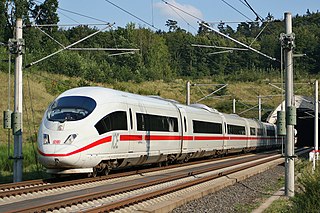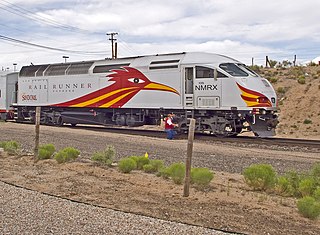Related Research Articles

A multiple-unit train is a self-propelled train composed of one or more carriages joined, and where one or more of the carriages have the means of propulsion built in. By contrast, a locomotive-hauled train has all of the carriages unpowered.

The Trinity Railway Express (TRE) is a commuter rail service in the Dallas–Fort Worth metroplex, Texas, United States. It was established by an interlocal agreement between Dallas Area Rapid Transit (DART) and Trinity Metro. Each transit authority owns a 50% stake in the joint rail project and contractor Herzog Transit Services operates the line. The TRE began operating in December 1996.

The EMD F40PH is a four-axle 3,000–3,200 hp (2.2–2.4 MW) B-B diesel-electric locomotive built by General Motors Electro-Motive Division in several variants from 1975 to 1992. Intended for use on Amtrak's short-haul passenger routes, it became the backbone of Amtrak's diesel fleet after the failure of the EMD SDP40F. The F40PH also found widespread use on commuter railroads in the United States and with VIA Rail in Canada. Additional F40PH variants were manufactured by Morrison-Knudsen and MotivePower between 1988 and 1998, mostly rebuilt from older locomotives.

The EMD F59PH is a four-axle 3,000 hp (2 MW) B-B diesel-electric locomotive built by General Motors Electro-Motive Division from 1988 to 1994. A variant, the F59PHI, was produced from 1994 to 2001. The F59PH was originally built for GO Transit commuter operation in the Toronto region. Metrolink in Southern California also purchased a fleet for its 1992 launch. The streamlined F59PHI was designed for Amtrak California intercity service. A total of 72 F59PH and 83 F59PHI locomotives were built.
Bombardier Transportation was a Canadian-German rolling stock and rail transport manufacturer, with headquarters in Berlin, Germany. It was one of the world's largest companies in the rail vehicle and equipment manufacturing and servicing industry. Bombardier Transportation had many regional offices, production and development facilities worldwide. It produced a wide range of products including passenger rail vehicles, locomotives, bogies, propulsion and controls. In February 2020, the company had 36,000 employees, and 63 manufacturing and engineering locations around the world. Formerly a division of Bombardier Inc., the company was acquired by French manufacturer Alstom on 29 January 2021.

The passenger locomotives derivatives of the General Motors EMD GP40 diesel-electric locomotive have been, and continue to be, used by multiple passenger railroads in North America. For passenger service, the locomotives required extra components for providing steam or head-end power (HEP) for heating, lighting and electricity in passenger cars. Most of these passenger locomotives were rebuilt from older freight locomotives, while some were built as brand new models.

The MPI MPXpress is a line of diesel-electric locomotives built by MotivePower for commuter rail service. There are five MPXpress models: MP36PH-3S, MP36PH-3C, MP40PH-3C, MP32PH-Q, and MP54AC.

The history of rapid transit began in London with the opening of the Metropolitan Railway, which is now part of the London Underground, in 1863. By World War I, electric underground railways were being used in Athens, Berlin, Boston, Buenos Aires, Budapest, Glasgow, Hamburg, Istanbul, Liverpool, New York City, Paris, and Philadelphia.

SEMTA Commuter Rail, also known as the Silver Streak, was a commuter train operated by the Southeastern Michigan Transportation Authority (SEMTA) and the Grand Trunk Western Railroad between Detroit and Pontiac, Michigan. It began in 1974 when SEMTA assumed control of the Grand Trunk's existing commuter trains over the route. SEMTA discontinued operations in 1983. Amtrak began offering intercity service between Detroit and Pontiac in 1994 as part of its Michigan Services.
References
- ↑ "Railroad Fallen Flags: C". Classic Trains. Waukesha, WI: Kalmbach Publishing. 2006-06-26. Retrieved 2008-02-26.
- ↑ "Railway Rampage, Commuters Riot". Spokane Daily Chronicle. 13 March 1973.
- ↑ Low, Nicholas (2013). Transforming urban transport: the ethics, politics and practices of sustainable mobility. Routledge. pp. 99–102. ISBN 9780415529037.
- ↑ City of Toronto (2006). "Toronto Transit Commission – History". Archived from the original on 29 March 2006. Retrieved 2006-03-29.
- 1 2 "BART Chronology January 1947 – March 2009" (PDF). San Francisco Bay Area Rapid Transit District. March 2009. Archived from the original (PDF) on October 13, 2013.
- ↑ Balkwill, Richard; Marshall, John (1993). The Guinness Book of Railway Facts and Feats (6th ed.). Enfield: Guinness Publishing. ISBN 0-85112-707-X.
- ↑ Ingles, J. David (December 1975). "The power behind the pointless arrow". Trains . 36 (2): 23.
- ↑ Sanders, Craig (2006). Amtrak in the Heartland. Bloomington, Indiana: Indiana University Press. p. 227. ISBN 978-0-253-34705-3.
- ↑ "東京都交通局,交通局について,都営地下鉄" [History of the Transportation Bureau]. kotsu.metro.tokyo.jp (in Japanese). Archived from the original on 23 February 2024. Retrieved 12 July 2024.
- ↑ "John W. Barriger; Rail historian and railfan". Archived from the original on 2005-03-01. Retrieved 2005-02-22.